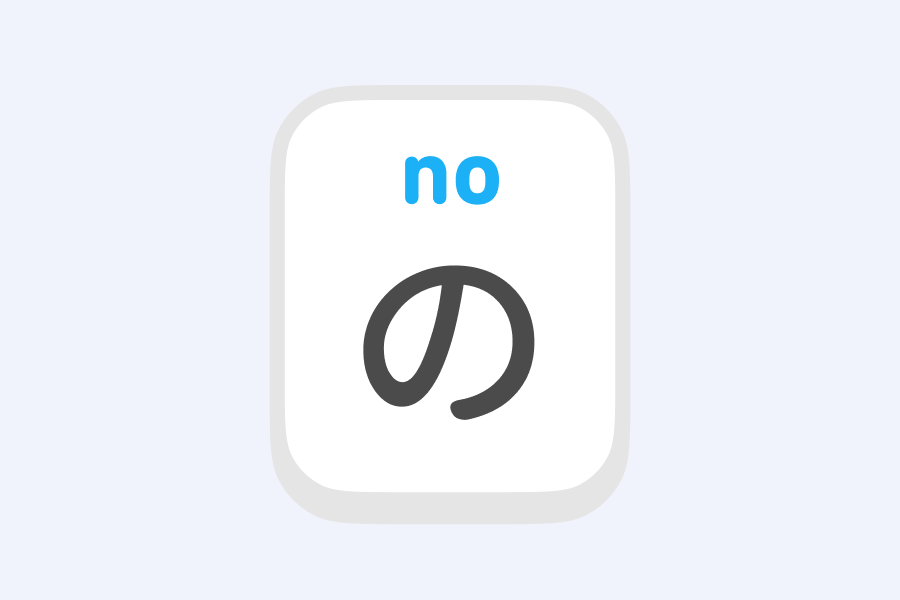It doesn't take long for Japanese learners to encounter one small word that carries many different meanings: の, a particle that is pronounced "no." A particle is a word whose only purpose is to show a relationship between other words, for example, to indicate that a sentence is a question. We don't have particles in English, so if you're studying Japanese, you're learning something entirely new!
の is one of many particles in Japanese, and there are actually a few really different uses of の. Here are the most common:
- の to link nouns together
- の to mean the pronoun "one," as in 青いの (aoino, "blue one")
- の at the end of a sentence for emphasis or to ask for an explanation (you'll hear this emphasis a lot in anime!)
That first kind of の—to link together nouns or a noun and a pronoun and show the relationship between them—is actually a large category, and it's used to show many kinds of meanings. Some of these meanings match some of the ways we use "from," "of," "about," and "as" in English. Here's how to use の for so many different meanings.
の for possession
The particle の can be used to show that someone or something possesses an object. One of the ways we do this in English is with words like "my," "our," or "their," but in Japanese you add "no" instead—so you'll say みさとの電話 (Misato NO denwa) for "Mistato's phone" (literally, "Misato の phone) or 私の電話 (watashi NO denwa) for "my phone" (literally, "I の phone").
の for kinds of work
Another way to use の is for a special kind of possession: for someone's work. In English, we often use "as" in these contexts, to say what someone works "as." In Japanese, to say that someone works as an engineer, you'll say エンジニアの仕事 (enjinia NO shigoto), as in エンジニアのしごとは大変です(enjinia NO shigoto wa taihen desu, "The work as an engineer is hard").
の for origin and nationality
の can also be used to link a country or place with a noun, to show the nationality or origin of the noun. Instead of using an adjective like "American" or "Japanese," in Japanese you'll use the noun for country, together with the の particle. For example, アメリカの映画 (America NO eiga) is literally "America の movie," which means "American movie." It can be helpful to think of this sort of like "from" in English, with the words in a different order—in English we can say "car from Japan," "book from the library," etc.
の for weather
Another example where we use adjectives in English but nouns and の in Japanese is to describe the weather. In English, we'll say a day is "sunny" or "rainy," but in Japanese there are special weather terms that you'll combine with 日 (hi, "day"). For example, 晴れの日 (hare NO hi) is the expression for "sunny day" (literally ”clear weather の day”), and 雨の日 (ame NO hi) means "rainy day" (literally “rain の day”). These 3-word phrases don't have a word-for-word equivalent in English, so the best way to learn them is to learn the whole phrase together (and not each part individually).
の for someone's expertise
The particle の is also used to say what subject a teacher teaches. For example, you'll say 日本語の先生 (nihongo NO sensei) for "Japanese teacher" (someone who teaches Japanese) and サッカーのコーチ (sakkaa NO koochi) for "soccer coach." For this use of の, think of how we use "of" in English, with a different word order: in English, "coach of soccer," "teacher of Japanese," "researcher of biology," etc.
の for time
Another way you'll use の is to say at what time something (a noun) is happening. It's used for time, as in 5時の会議 (goji NO kaigi) for "five o'clock meeting," as well as for days of the week, as in 金曜日のパーティー (kinyoubi NO paatii) for "party on Friday."
There's *no* better time to learn Japanese!
Japanese is full of phrases and structures unlike English, and the uses of の to connect nouns is just one of them. Keep discovering new grammar and expressions in your Duolingo lessons, and whenever you interact with Japanese, like by watching TV and movies, or making a playlist of Japanese music—or check out ours on Spotify!



